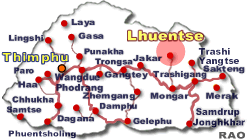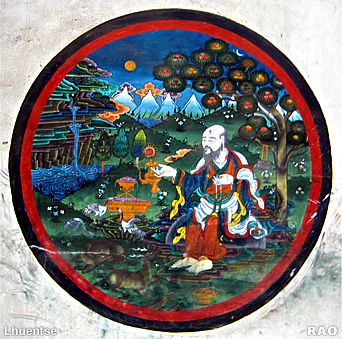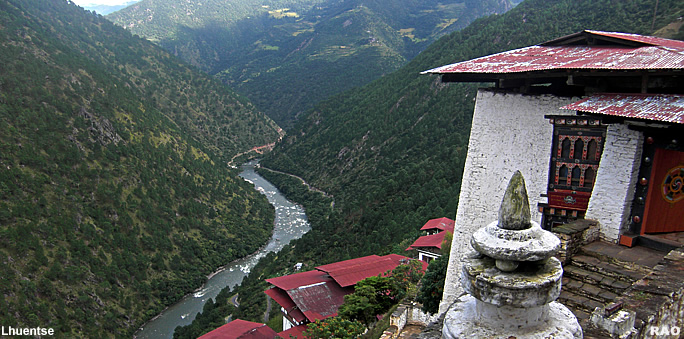|
Birth
Place of the Royal Family |
 |
Bhutan Royal Family |
|
|
|
|
Dungkar:
Birth Place of the Royal Family
|
 |
 |
| Dungkar,
the northern-most village of Kurtoe, has long been renowned not only as
the birth place of Bhutan's royal family but as a land blessed by Guru
Rimpoche, and the site of several nyes (sacred places) such as Rinchen
Bumpa and Belyul Khenpajong. According to Lam Neten of Lhuenste Rabdey,
history has it that Guru Rimpoche meditated in a Dra-phu (meditation
cave) on the face of a steep cliff overlooking Dungkar - what we now know
as Rinchen Bumpa - from across the Kurichhu river. |
|
A
little further south, nestled higher up in the mountains, it is believed
that there is a hidden sacred abode of Guru Rimpoche, which will be revealed
at a pre-ordained time, for the preservation of the Dharma.
Dungkar
was also visited many times by Terton Pemalingpa, the great treasure revealer
of Bhutan, who lived in the 15th century.
 |
| Lhuentsedzong: wall painting |
| A lhakhang built by Pemalingpa on a flat stretch of land near the riverbed of Kurichhu, is known
as Goeshog Pang (meadow resembling the spread wings of an vulture).
Goeshog Pang is one of the most sacred sites in Kurtoe. Pemalingpa also
built two sacred chortens, the renowned Phu-Sangda Chorten and Dha-Jangchub
Chorten, and brought forth a drup-chu (sacred spring) which still
flows today from under a tree near the house of the Dungkar Choejey (hereditary nobles).
The Dungkar Nagtshang was founded as a centre for the Peling tradition
in the later half of the 16th century by Drekha and Lankha, the twin sons
of Pemalingpa's grandson, Kuenga Gyaltshen. |
|
According
to legends, the three older brothers of the twins were approached by the
powerful local deity, Aum Wangchen Zangmo, to establish the centre, opposite
her abode, on a ridge shaped like a Dungkar (conch). Hence the Nagtshang
and its surroundings are known as Dungkar.
In
keeping with the purpose of building the Dungkar Nagtshang, as a centre
of the Peling tradition, rituals dedicated to Goempo Jatsha is performed
even to this day, on the first day of the eleventh lunar month, culminating
in a three-day Tshechu (mask dance festival) from the ninth day
to the eleventh day.
The
dances are all Terchhams (treasure dances), that were once choreographed
by Pemalingpa himself.
The
family members of the Dungkar Nagtshang, being descendants of a great personage
like Pemalingpa, are known as Dungkar Choejey.
Two
prominent sons of the Dungkar Choejey were Pila Goempo Wangyel and his
older brother, Pala Gyaltshen. Pila, who was born in 1782, went to Gangtoe
Goemba to stay with the Gangtoe Trulku Sizhi Namgyel. He led the army of
Zhabdrung Jigme Drakpa when the Zhabdrung and Sungtruel Yeshi Gyaltshen
were in conflict. After living in western Bhutan for several years, he
returned to Dungkar and lived separately at Khetangbi Nagtshang on a hill
overlooking the Dungkar Nagtshang.
Pila
had five sons, one of which was Jigme Namgyel, born in 1825, who became
the dynamic and powerful Trongsa Penlop. Jigme Namgyel successfully led
Bhutanese forces against the British in Dewangiri, and laid the foundation
for the emergence of the Wangchuck dynasty and the start of a new era of
peace and stability in Bhutan after many years of internal strife and conflict.
Khetangbi
Nagtshang was rebuilt and expanded during Jigme Namgyel's time by his sister,
Ashi Tshewang Dem. It has since been known as the Jigme Namgyel Nagtshang
and is looked after, today, by the Lhuentse Rabdey. Religious ceremonies
in keeping with the traditions established in the time of Pila Goenpo Wangyal
and Trongsa Penlop Jigme Namgyel are still being performed to this day.
 |
| Contributed
by Kesang Dema and Rinzin Wangchuk, Bhutan's National Newspaper, April
2007 |
|




